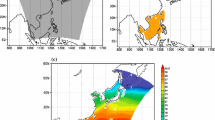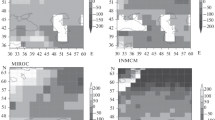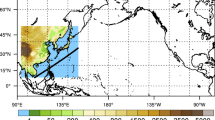Abstract
With a fall of the Caspian Sea level (CSL), its size gets smaller and therefore the total evaporation over the sea is reduced. With a reduced evaporation from the sea, the fall of the CSL is weakened. This creates a negative feedback as less evaporation leads to less water losses of the Caspian Sea (CS). On the other hand, less evaporation reduces the water in the atmosphere, which may lead to less precipitation in the catchment area of the CS. The two opposite feedbacks are estimated by using an atmospheric climate model coupled with an ocean model only for the CS with different CS sizes while keeping all other forcings like oceanic sea surface temperatures (SSTs) and leaf area index the same from a global climate simulation. The investigation is concentrated on the medieval period because at that time the CSL changed dramatically from about − 30 to − 19 m below the mean ocean sea level, partly man-made. Models used for simulating the last millennium are not able to change the size of the CS dynamically so far. When results from such simulations are used to investigate the CSL variability and its causes, the present study should help to parameterize its feedbacks.
A first assumption that the total evaporation from the CS will vary with the size of the CS (number of grid points representing the sea) is generally confirmed with the model simulations. The decrease of grid points from 15 to 14, 10, 8 or 7 leads to a decrease of evaporation to 96, 77, 70 and 54%. The lower decrease than initially expected from the number of grid points (93, 67, 53 and 47%) is probably due to the fact that there would also be some evaporation at grid points that run dry with a lower CSL but a cooling of the CS SST with increasing CS size in summer may be more important. The reduction of evaporation over the CS means more water for the budget of the whole catchment of the CS (an increase of the CSL) but from the gain through reduced evaporation over the CS, only 70% is found to remain in the water budget of the whole catchment area due to feedbacks with the precipitation. This suggests a high proportion of recycling of water within the CS catchment area.
When using a model which does not have a correct CS size, the effect of a reduced CS area on the water budget for the whole CS catchment can be estimated by taking the evaporation over the sea multiplied by the proportional changed area. However, only 50% of that change is ending up in the water balance of the total catchment of the CS. A formula is provided. This method has been applied to estimate the CSL during the Last Glacial Maximum to be at − 30 to − 33 m.
The experiments show as well that the CS has an impact on the large-scale atmospheric circulation with a widened Aleutian 500 hPa height field trough with increasing CS sizes. It is possible to validate this aspect with observational data.













Similar content being viewed by others
References
Amante C, Eakins BW (2009) ETOPO1 1 Arc-minute global relief model: procedures, data sources and analysis. NOAA Technical Memorandum NESDIS NGDC-24. National Geophysical Data Center, NOAA. doi:https://doi.org/10.7289/V5C8276M. https://www.ngdc.noaa.gov/mgg/global/global.html
Arpe, K., & Leroy, S. A. (2007). The Caspian Sea Level forced by the atmospheric circulation, as observed and modelled. Quat Int 173:144–152
Arpe K, Bengtsson L, Golitsyn GS, Mokhov II, Semenov VA, Sporyshev PV (2000) Connection between Caspian Sea level variability and ENSO. Geophys Res Lett 27(17):2693–2696
Arpe K, Leroy SAG, Mikolajewicz U (2011) A comparison of climate simulations for the last glacial maximum with three different versions of the ECHAM model and implications for summer-green tree refugia. Clim Past 7:1–24. https://doi.org/10.5194/cp-7-1
Arpe K, Leroy SAG, Mikolajewicz U (2014) A comparison of climate simulations for the last glacial maximum with three different versions of the ECHAM model and implications for summer-green tree refugia. Clim Past 7:1–242011, Theor Appl Climatol. https://doi.org/10.1007/s00704-013-0937-6
Chang CWJ, Tseng WL, Hsu HH, Keenlyside N, Tsuang BJ (2015) The Madden-Julian oscillation in a warmer world. Geophys Res Lett 42(14):6034–6042
Dee DP, Uppala SM, Simmons AJ, Berrisford P, Poli P, Kobayashi S, Andrae U, Balmaseda MA, Balsamo G, Bauer P, Bechtold P, Beljaars ACM, van de Berg L, Bidlot J, Bormann N, Delsol C, Dragani R, Fuentes M, Geer AJ, Haimberger L, Healy SB, Hersbach H, Hólm EV, Isaksen L, Kållberg P, Köhler M, Matricardi M, McNally AP, Monge-Sanz BM, Morcrette J-J, Park B-K, Peubey C, de Rosnay P, Tavolato C, Thépaut J-N, Vitart F (2011) The ERA -interim reanalysis: configuration and performance of the data assimilation system. Q J R Meteorol Soc 137, 656:553–597, Part A. https://doi.org/10.1002/qj828
Dietrich DE (1998) Application of a modified Arakawa ‘a’grid ocean model having reduced numerical dispersion to the Gulf of Mexico circulation. Dyn Atmos Oceans 27(1):201–217
ECMWF (2015) http://apps.ecmwf.int/datasets. Last access May 2015
Forte AM, Cowgill E (2013) Late Cenozoic base-level variations of the Caspian Sea: a review of its history and proposed driving mechanisms. Paleogeogr Palaeoclimatol Palaeoecol 386:392–407
Hagemann S, Arpe K, Roeckner E (2006) Evaluation of the hydrological cycle in the ECHAM5 model. J Clim 19:3810–3827. https://doi.org/10.1175/JCLI3831.1
Jungclaus JH, Lorenz SJ, Timmreck C, Reick CH, Brovkin V, Six K, Segschneider J, Giorgetta MA, Crowley TJ, Pongratz J, Krivova NA, Vieira LE, Solanki SK, Klocke D, Botzet M, Esch M, Gayler V, Haak H, Raddatz TJ, Roeckner E, Schnur R, Widmann H, Claussen M, Stevens B, Marotzke J (2010) Climate and carbon-cycle variability over the last millennium. Clim Past 6:723–737. https://doi.org/10.5194/cp-6-723-2010
Kakroodi AA, Kroonenberg SB, Hoogendoorn RM, Mohammadkhani H, Yamani M, Ghassemi MR, Lahijani HAK (2012) Rapid Holocene sea-level changes along the Iranian Caspian coast. Quat Int 263:93–103
Kislov A, Panin A, Toropov P (2012) Palaeostages of the Caspian Sea as a set of regional benchmark tests for the evaluation of climate model simulations. Clim Past Discuss 8:5053–5081. www.clim-past-discuss.net/8/5053/2012/. https://doi.org/10.5194/cpd-8-5053-2012
Klige RK (1990) Historical changes of the regional and global hydrological cycles. GeoJournal 20(2):129–136
Lan YY, Tsuang BJ, Tu CY, Wu TY, Chen YL, Hsieh CI (2010) Observation and simulation of meteorology and surface energy components over the South China Sea in summers of 2004 and 2006. Terr Atmos Ocean Sci 21(2):325–342
Large WG, Caron J (2015) Diurnal cycling of sea surface temperature, salinity, and current in the CESM coupled climate model. J Geophys Res Oceans 120:3711–3729. https://doi.org/10.1002/2014JC010691
Leroy SAG, Lahijani HAK, Djamali M, Naqinezhad A, Moghadam MV, Arpe K, Shah-Hosseini M, Hosseindoust M, Miller CS, Tavakoli V, Habibi P, Naderi Beni M (2011) Late Little Ice Age palaeoenvironmental records from the Anzali and Amirkola lagoons (South Caspian Sea): vegetation and sea level changes. Palaeogeogr Palaeoclimatol Palaeoecol 302:415–434
Mamedov AV (1997) The late Pleistocene-Holocene history of Caspian Sea. Quat Int 41/42:161–166
Marković SB, Ruman A, Gavrilov MB, Stevens T, Zorn M, Komac B, Perko D (2014) Modelling of the Aral and Caspian seas drying out influence to climate and environmental changes. Acta Geogr Slov 54(1):143–161
Molavi-Arabshahi M, Arpe K, Leroy SAG (2015) Precipitation and temperature of the Southwest Caspian Sea region during the last 55 years: their trends and teleconnections with large-scale atmospheric phenomena. Int J Climatol. https://doi.org/10.1002/joc4483
Naderi Beni A, Lahijani H, Mousavi Harami R, Arpe K, Leroy SAG, Marriner N, Berberian M, Andrieu-Ponel V, Djamali M, Mahboubi A, Reimer PJ (2013) Caspian Sea-level changes during the last millennium: historical and geological evidence from the south Caspian Sea. Clim Past 9:1645–1665. www.clim-past.net/9/1645/2013. https://doi.org/10.5194/cp-9-1645-2013
Panin A, Matlakhova E (2015) Fluvial chronology in the East European Plain over the last 20 ka and its palaeohydrological implications. Catena 130:46–61
Renssen H, Longhead BC, Aerts JCJH, de Moel H, Ward PJ, Kwadijk JCJ (2007) Simulating long-term Caspian Sea level changes; The impact of Holocene and future climate conditions. Earth Planet Sci Lett 261:685–693
Roeckner E, Brokopf R, Esch M, Giorgetta M, Hagemann S, Kornblueh L, Manzini E, Schlese U, Schulzweida U (2006) Sensitivity of simulated climate to horizontal and vertical resolution in the ECHAM5 atmosphere model. J Clim 19(16):3771–3791
Smagorinsky J (1963) General circulation experiments with the primitive equations, I The basic experiment. Mon Weather Rev 91:99–164
Svitoch AA (2009) Khvalynian transgression of the Caspian Sea was not a result of water overflow from the Siberian proglacial lakes, nor a prototype of the Noachian flood. Quat Int 197:115–125
Toropov PA, Morozova PA (2010) Evaluation of Caspian Sea level at late Pleistocene period (on the base of numerical simulation adjusted for Scandinavian glacier melting) 134–138 Proceedings of the international conference THE CASPIAN REGION: ENVIRONMENTAL CONSEQUENCES OF THE CLIMATE CHANGE. Moscow State University, faculty of geography, Russian Foundation for basic research, 14–16 Oct., 2010. https://istina.msu.ru/collections/1550121/http:/www.ngdc.noaa.gov/mgg/global/global.html/ https://doi.org/10.1002/2014JC010691https
Tseng YH, Chien MH (2011) Parallel Domain-decomposed Taiwan Multi-scale Community Ocean Model (PD-TIMCOM). Comput Fluids 45(1):77–83
Tseng YH, Dietrich DE, Ferziger JH (2005) Regional circulation of the Monterey Bay region: hydrostatic versus nonhydrostatic modeling. J Geophys Res Oceans 110(C9). https://doi.org/10.1029/2003JC002153
Tseng YH, Shen ML, Jan S, Dietrich DE, Chiang CP (2012) Validation of the Kuroshio current system in the dual-domain Pacific Ocean model framework. Prog Oceanogr 105:102–124
Tseng WL, Tsuang BJ, Keenlyside NS, Hsu HH, Tu CY (2015) Resolving the upper-ocean warm layer improves the simulation of the madden–Julian oscillation. Clim Dyn 44(5–6):1487–1503
Tsuang B-J, Tu C-Y, Arpe K (2001) Lake parameterization for climate models. Max-Planck-Institut für Meteorologie, Hamburg
Tsuang BJ, Tu CY, Tsai JL, Dracup JA, Arpe K, Meyers T (2009) A more accurate scheme for calculating Earth’s skin temperature. Clim Dyn 32(2–3):251–272
Tu CY, Tsuang BJ (2005) Cool-skin simulation by a one-column ocean model. Geophys Res Lett 32(22)
Tudryn A, Chalié F, Lavrushin YA, Antipov MP, Spiridonova EA, Lavrushin V, Tucholka P, Leroy SAG (2013) Late quaternary Caspian Sea environment: late Khazarian and early Khvalynian transgressions from the lower reaches of the Volga river. Quat Int 292:193–204
Tudryn A, Leroy SAG, Toucanne S, Gibert-Brunet E, Tucholka P, Lavrushin YA, Dufaure O, Miska S, Bayon G (2016) The Ponto-Caspian basin as a final trap for southeastern Scandinavian ice-sheet meltwater. Quat Sci Rev 148:29–43
UNEP-Dewa (2003) Freshwater in Europe. Last accessed 25 March 2017
Van der Vorst HA (1992) Bi-CGSTAB: a fast and smoothly converging variant of Bi-CG for the solution of nonsymmetric linear systems. SIAM J Sci Stat Comput 13(2):631–644. https://doi.org/10.1137/0913035 https://en.wikipedia.org/wiki/Biconjugate_gradient_stabilized_method
Young CC, Tseng YH, Shen ML, Liang YC, Chen MH, Chien CH (2012) Software development of the Taiwan Multi-scale Community Ocean Model (TIMCOM). Environ Model Softw 38:214–219
Young CC, Liang YC, Tseng* YH, Chow CH (2014) Characteristics of the RAW filtered leapfrog time-stepping scheme in the ocean general circulation model. Mon Weather Rev 142:434–447
Acknowledgements
We are grateful to the National Center for High-performance Computing/Taiwan for computer time and facilities. We thank Reviewer no. 4 for his constructive suggestions, which led to improvements of the manuscript.
Funding
This study was supported with funds from the project MOST/TW 103-2621-M-005-003, 104-2621-M-005-006, 105-2621-M-005-001, 106-2111-M-005-001 and 106-2111-M-002-001.
Author information
Authors and Affiliations
Corresponding author
Rights and permissions
About this article
Cite this article
Arpe, K., Tsuang, BJ., Tseng, YH. et al. Quantification of climatic feedbacks on the Caspian Sea level variability and impacts from the Caspian Sea on the large-scale atmospheric circulation. Theor Appl Climatol 136, 475–488 (2019). https://doi.org/10.1007/s00704-018-2481-x
Received:
Accepted:
Published:
Issue Date:
DOI: https://doi.org/10.1007/s00704-018-2481-x




